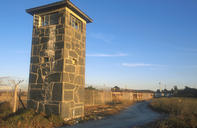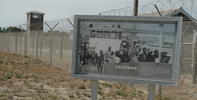A Shift in Political Power

In 1948, the Nationalist Party won the general election and General Jan Smuts was removed from power. It was the start of 50 years of oppression and segregation – an era that has come to be summarised by the word ‘apartheid’. Over the next few decades, the government would gradually implement a series of laws that were designed to curtail the liberties of South Africans of colour.
While the motivations for this legislation are undoubtedly based on racial prejudice, there was another over-riding reason for this calculated policy of denigration: the need to ensure that there was always a steady supply of cheap black labour.
This approach to government meant that legislation would be met with resistance and protest. The authorities therefore realised that they would need a place to put all those who defied the state. Thus, in 1959, the Minister of Justice announced that Robben Island was going to once more become a prison. The military installations were relocated to the mainland and all access to the island was restricted. A new and terrible chapter in the island’s history had begun.
The Apartheid Years

In 1958, Dr. H.F. Verwoerd took over as South Africa's Prime Minister. He was instrumental in creating the ‘apartheid’ system, and separate development. In exchange for the labour and subservience of people of colour, Verwoerd promised to look after the blacks in the best tradition of Christian guardianship. Verwoerd knew that there would be opposition from the people, and the decision was taken to prepare Robben Island as a prison for all of those who opposed the state.
During this time, the infamous Treason Trial had started, which saw 150 defendants of all races charged with conspiracy against the state. As from 1961, criminal prisoners were sent to the island to help prepare it for the anticipated influx of political prisoners. The Treason Trail ended after four years with no convictions. By this time, the African National Congress (ANC) was a nationally supported political organisation that fought the apartheid government.
The movement had already led many, largely peaceful, protests against the government. Their lack of progress frustrated some, however, and one firebrand named Robert Sobukwe broke away from the ANC to start a more militant group, called the Pan Africanist Congress (PAC), in 1959.
The First Political Prisoners Sent to Robben Island

In 1960, the mass-action Defiance Campaign was mounted against the draconian Pass Laws that restricted the movement of black people through white areas. At one of these protests, outside a police station in Sharpeville, near Vereeniging, the police opened fire on the crowd. They killed 69 people, most of whom were shot in the back as they were running away. The event shocked the nation and the international community.
The South African government’s reaction was swift. The African National Congress (ANC) and the Pan African Congress (PAC) were declared illegal organisations and banned. New laws were promulgated to make it easier to arrest and imprison opposition leaders. Later, South Africa's leader Verwoerd would leave the British Commonwealth and declare South Africa a Republic.
For their part, both the PAC and the ANC decided to take up arms in the struggle against apartheid, and both established military wings, named Poqo and Umkhonto we Siswe respectively. In the aftermath of Sharpeville, a peaceful student protest turned violent as police opened fire on students, the first political prisoners to be arrested and sent to Robben Island. They were mainly PAC and Poqo members.
They arrived from 1961 onwards, landing on a rough island that had only recently been abandoned by the military and was in no-way ready to be a maximum security prison. The first prisoners were therefore quickly put to work quarrying stone and building their cells.
By David Fleminger